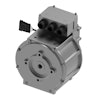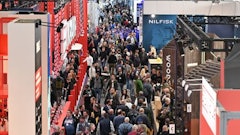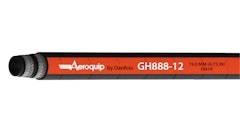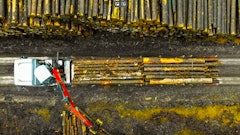Paul Ballard has a strong relationship with vehicle technicians working for mine companies and listens to their complaints. He knew his customers had to stop.
"The equipment specialists at the mines say the personnel carriers are reliable as far as the engines and drivetrains go, but one of the largest problem areas was the brakes," says Ballard.
He is president of the Fluid Power House branch near Sudbury, Ontario, Canada, a distributor specializing in brakes and control systems. Sudbury is the central city for several hard rock mine operations and is home to an extensive support network. The components Fluid Power House supplies to local OEMs spend their working lives deep underground.
Brake pads on the light utility vehicles used in the mines were being replaced nearly every week, while a complete rebuild was often necessary after 30 days.
The conditions to which the traditional discs and drums are exposed are severe. In Sudbury's mines "slime", a mixture of ground water, rock, blasting residue, and sulfuric acid, eventually cakes on the entire undercarriage. Add to the cement-like mixture a deep mine's high ambient temperature, an 8,000-lb. personnel carrier, and a long 20% incline through a narrow tunnel: without constant maintenance, miners have a vehicle that simply won't stop.
"It's a frightening ride without brakes," says Ballard. "Safety is a huge deal."
The vehicle of choice in the area mines has been Toyota's LandCruiser 70 Series, which is not available to the North American public. Sold only for industrial applications, "upfitters" tear down and rebuild the Toyotas to upgrade wiring, safety and emissions equipment to meet mine regulations. Options are also installed that include cranes, service boxes or additional seats. The personnel carriers transport miners to the stopes, many miles from the elevator that leads to the surface 9,000 ft. above.
The Toyotas are popular because they are less expensive than a purpose-built utility vehicle. Even in stock configurations, the rugged workhorses have been proven in tough conditions worldwide. "LandCruisers have stood up about as good as you can expect for a non-purpose built machine," says Ballard. "They fill a niche."
Brakes have been the weak point. Few industries enjoy equipment downtime, but in mining there is very little patience for it. Maintenance on a utility vehicle working below ground presents some unique logistical problems that add to the cost, especially if an elevator must be used to carry the vehicle to the surface. That monthly brake overhaul may cost up to $1,000.
"One of the challenges with a mine's utility vehicle is that production vehicles get priority," says Ballard. "If you have a haul truck down the same time as a personnel carrier, mines work on the truck first. The utility vehicle could be out of service longer than you would want."
Problem in search of solution
Enclosed disc brakes have solved the problem in large mine trucks, but they are traditionally too heavy or expensive — in terms of initial installation and maintenance — for utility vehicles. Ballard saw a need for a new enclosed brake and approached MICO, Inc., North Mankato, MN, a company he has worked with for 25 years.
"We said ‘we've gone to the mines; we've talked to the fleet managers, and we think this is a viable project,'" says Ballard. "‘You guys are the design specialists. Let's work together and see what we can do.'"
It proved to be a good team. MICO's solution is a wet-type multiple disc wheel-end brake with a spring-applied, hydraulic release for parking and emergency braking. It is equipped with MICO's patented pressure override function for regular service braking. The override system allows the brake to operate in a fail-safe mode with a spring applied, while also allowing normal modulation.
Instead of requiring special brake fluid, MICO engineers opted for flow-through cooling. "The system is not brake-fluid based," says David Ringler, product development manager, MICO Inc., "but a mineral-based hydraulic system. That is where MICO fits in the industry. We do hydraulic brakes, brake actuators and controls for off-highway equipment."
Initial field tests were performed with a modified LandCruiser. The brakes passed their first ramp test and then went underground, where they have operated successfully for more than 1,000 hrs. There are three vehicles equipped with the brake now: two LandCruisers and a Minecat T99, a purpose-built utility vehicle manufactured by Industrial Fabrication in Sudbury. The brake has recently been made available to OEMs.
The maximum static torque rating for the parking/emergency brake function is 40,000 lbs-in. at 0 psi, while the service brake override has a maximum dynamic torque rating of 30,000 lbs-in. at 1,500 psi. At maximum torque, the brake has an initial release pressure of 500 psi and full release pressure of 600 psi. The spring-applied section of the brake requires 1.0 to 2.0 cu. in. of oil, while between 0.23 and 0.46 cu. in. of oil is needed for the service brake section — smaller amounts than other systems require.
Although the existing vehicles such as the LandCruiser must be modified (it requires 3/8-in. tubing and a new boosted master cylinder) to work with MICO brake's actuation system, all existing vehicle bearings and drive components can be used. Strictly for off-highway applications, the brakes are designed for speeds under 30 mph, in vehicles below 10,000 GVW.
Custom(er) solutions
Ringler says the majority of MICO's business comes from OEMs that require unique solutions to specific challenges. Many of its products have only one customer.
"The wheel-end brake is a unique case where we were approached by a distributor who needed a solution to satisfy an entire market," says Ringler. "Before we take on a project, we have to be sure there is a market, and we have to understand the requirements. That takes time and cooperation between willing partners. This has not been a quick process. The beautiful thing with Paul is he has the mining expertise.
"MICO has a terrific set of distributors. They are more than a parts warehouse, as they understand the complete hydraulic system and add value to their customers" in terms of design assistance and, in this case, product development.
"Fluid Power House is unique in that it often shares some of the burden in machine development if the opportunity is there," says Ballard. "We work in partnership with local manufacturers and share the risk."
The mining sector is running strong, and Ballard expects Fluid Power House will stay busy supplying the OEMs that support the industry. He sees possible applications in utility vehicles used at surface mines, as well, such as in the Oil Sands in Alberta.
The wheel brake has just recently become available. While it was in the test phase MICO talked with a number of mining-related companies around the world which are interested in the product. "The mining community is so small if you come up with something that works it can be around the globe in about a week," says Ballard."















